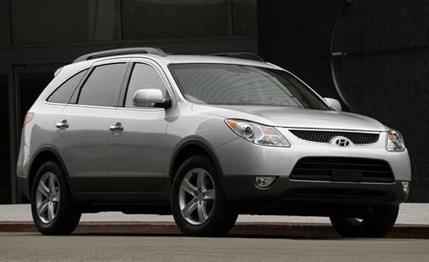 First Drive Review
First Drive Review
Plop down into the driver's seat of the Hyundai Veracruz, and you'll find yourself in the middle of a quiet, comfortable, content-rich revelation. With a smooth, competent powertrain and luxury touches everywhere you look, it's not hard to convince yourself that you're behind the wheel of a Lexus. That's hardly a shock, of course, given that Hyundai chose the Lexus RX350 as the benchmark for its seven-passenger Veracruz, which is now the largest SUV in Hyundai's lineup.
A Smokin' Deal
We tested an upscale front-wheel-drive Limited model, but all-wheel drive is available on any trim level for a $1700 premium. Ours was $33,120, with the only extra a set of floor mats for $125. Those luxury touches we mentioned? Mood lighting, heated leather seats, a six-CD Infinity stereo, a power liftgate, a sunroof, and auto-dimming rearview and side mirrors are all standard. Granted, many of those items are optional on lesser trim levels, but even the base Veracruz includes second-row climate controls, satellite radio, six airbags, and defroster-equipped side mirrors for $26,995, $100 less than an entry-level Honda Pilot and $500 or so less than a similarly outfitted Toyota Highlander. (A base Highlander costs some $1500 less than a Veracruz but doesn't include a V-6 or third-row seating.) Should you feel particularly self-indulgent, available packages will add anything from a rear-seat DVD entertainment system to an upgraded, 605-watt stereo to power-adjustable pedals to hands-free keyless entry.
Refined and Smooth: Hyundai Hallmarks?
A 3.8-liter, 24-valve V-6 is the only engine for the Veracruz, no matter which trim level you choose—GLS, SE, or Limited. Its 260 horsepower provides acceleration that we can't call particularly fast or ridiculously slow. Figure on about eight seconds for the 0-to-60-mph benchmark. But power delivery is very linear, and there's a respectable 257 pound-feet of torque. The big Hyundai is quiet, too. Very little engine noise makes it into the cabin, and at idle, the Veracruz is so quiet and vibration-free that, if you're like us, you'll need to double-check that you've twisted the key before slipping into gear. Fuel-economy ratings are 18 mpg city and 25 mpg highway, on par with the Pilot and Highlander. As refined as the V-6 is, the best part of the drivetrain is perhaps the Aisin-sourced six-speed automatic, Hyundai's first. Upshifts are hiccup-free and quick, and the box operates so seamlessly, you hardly know it's there. There's a manumatic shifting feature, although tipping the lever toward the passenger side to activate it rather than toward the driver seems backward.
The strut-front and multilink-rear suspension delivers a plush, comfortable ride, especially on the freeway, and we found body control to be exemplary. Sure, there's some lean when you pitch the Veracruz into a corner with any aggression, but it's taken care of so quickly that you hardly care. This is certainly no bobbing oceanliner, and there's little of the rear-end wiggle that usually accompanies soft-riding vehicles with a high center of gravity. The steering has luxury-grade heft but unfortunately is as dead as Orson Welles; you'd be better off looking for feedback from a room full of mimes than from this rack. The brakes are nothing special, although at least there's no dead zone in initial pedal travel—when you call on the brakes, you get brakes.